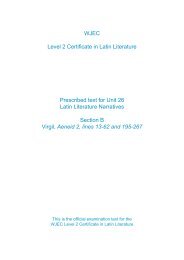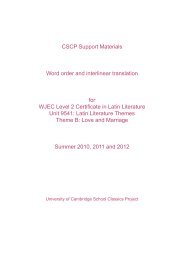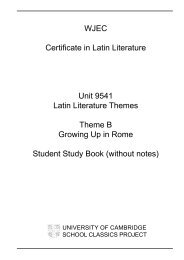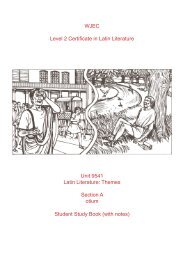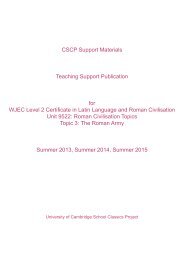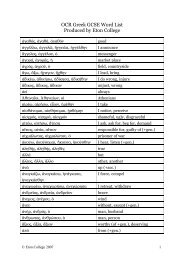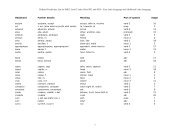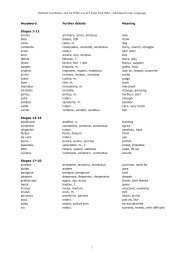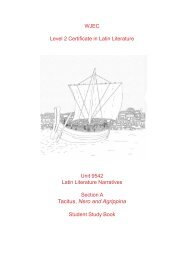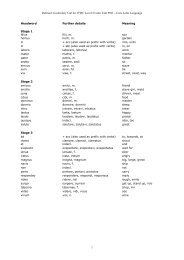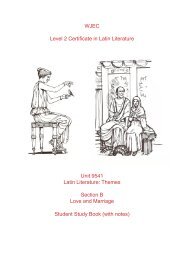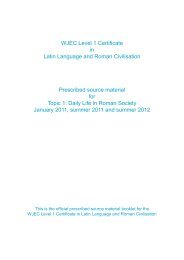pdf format here - Cambridge School Classics Project
pdf format here - Cambridge School Classics Project
pdf format here - Cambridge School Classics Project
Create successful ePaper yourself
Turn your PDF publications into a flip-book with our unique Google optimized e-Paper software.
The <strong>Cambridge</strong> Latin Course and Citizenship at Key Stage 3Aim of this documentFrom August 2002, secondary schools will be required to teach citizenship at keystages 3 and 4. Citizenship at key stages 3 and 4: Initial guidance for schoolsencourages schools to teach the programme of study through a combination ofdiscrete citizenship lessons, activity days and weeks and through other schoolsubjects. This document provides an outline of the opportunities provided by the<strong>Cambridge</strong> Latin Course (CLC) for teaching aspects of citizenship. It has been writtenwith two groups in mind:• current <strong>Classics</strong> teachers seeking to demonstrate the contribution of Latin tothe teaching of citizenship;• teachers wishing to justify the introduction of Latin on to their schooltimetable.It focuses on the CLC Books I and II because few schools go beyond Book II by theend of Year 9. The CLC and Result CLC (multi-media materials based on Book I ofthe CLC and intended to be used in conjunction with it, currently being trialled for theDfES) do not cover all the requirements of the programme of study for citizenship,and so this document should be read in conjunction with Citizenship: NationalCurriculum, key stages 3 and 4.ContentsThis document has 3 sections:Section 1: how the historical context of the CLC lends itself to discussion of today’scitizenship issues;Section 2: an examination of 2 Stages in Book I of the CLC (rhetor and candidati)and 2 in Book II (apud Salvium and Alexandria), which provide particularopportunities for stimulating discussion of citizenship;Section 3: tables giving a detailed breakdown of the links between the CLC Books Iand II and citizenship.Section 1The CLC and Result CLCStudy of the Romans concerns a people who were identified by the complex nexus oftheir sometimes conflicting loyalties. As a highly politicised society, with degrees ofcitizenship and belonging, the Roman world provides an appropriate basis for theexamination of citizenship issues in the modern world. Furthermore, much of thepolitical vocabulary used today (oratory, candidate, senate, election, vote, govern) isderived from Latin, and students can become familiar with this terminology throughLatin.With their emphasis on the cultural background of the Roman world in the firstcentury AD, the CLC Books I and II and Result CLC particularly lend themselves tothe study of many aspects of citizenship. As the <strong>Cambridge</strong> Latin Course Book ITeacher’s Guide states in its introduction, “Through Latin, students gain insight intoelements of western European and other societies: language, literature, law, attitudesto religion, civil engineering and technology, and political structures”.QCA 2000
Book I of the CLC looks at the community of Pompeii and the familia of Caecilius,and is particularly concerned with family life, social roles and responsibilities andlocal government and elections. Pompeii was part of the Roman Empire and itscitizens thought of themselves as Pompeians and Romans; they were very muchconcerned with the running of their own town, yet the emperor in Rome held ultimatecontrol, as evidenced, for instance, by Nero’s intervention in the riot described inStage 8. Book II looks at Rome’s imperial power further afield, focusing on RomanBritain, which is clearly an important component in the consideration of what itmeans to be British, and Roman Egypt. Here we see similar tensions about race andstatus to those seen now in multi-cultural Britain and worldwide. In the first centuryAD Europe was a community within the Roman Empire, and the CLC looks at howthis was achieved and what it meant, an investigation inviting comparison with theEuropean Union and its future development, and the global community today.Extent to which the CLC and Result CLC cover the National Curriculumrequirements for citizenshipHow far teachers using the CLC and Result CLC cover the requirements of thecitizenship curriculum depends on the extent to which they take advantage of thenumerous opportunities for comparison between the Roman world and the worldtoday, which in turn depends on the time available to them. The ever-changing natureof current affairs means that up-to-the-minute comparisons cannot be incorporated inprinted or electronic teaching materials and are best left to the teacher. However, ascan be seen from the tables in Section 3, t<strong>here</strong> are suggestions in the CLC materialsfor modern-day comparisons on recurring issues, and also many opportunities <strong>format</strong>erial in the course to act as a springboard for discussion of current local, nationaland international events and problems.Comparisons between the Romans and the present day help students to make moresense of the world in which they live, and with such understanding should comeincreased tolerance, a significant goal of teaching. Drawing out modern parallels withthe Romans will not only cover some requirements of the citizenship programme ofstudy, but will also strengthen students’ grasp of the Roman world.Section 2Book I, Stages 10 and 11Stages 10 and 11 of Book I contribute to some elements of the first strand of theNational Curriculum for citizenship, Knowledge and understanding aboutbecoming informed citizens (see tables in Section 3). However, they dovetail sotightly with some of the other requirements that a more detailed treatment of theseStages will be helpful. Please refer to Citizenship: National Curriculum, key stages 3and 4 when curriculum strands are flagged in bold.Stage 10: rhetorStage 10 provides opportunities for discussion of educational systems, nationalismand stereotyping today. controversia consists of a debate on whether the Romans arebetter than the Greeks, and in statuae a Roman resolves the quarrel between twoGreek children. This material deals with debating, the need for proof to support one’sopinions and bias (citizenship curriculum strands 2a, 2b, 2c).
The exercise controversia (ILM, p56) brings out the difference between argumentumand sententia. Students must decide whether the proofs presented by the Roman aresatisfactory, and why. They decide if the verdict in the story was fair, and whetherbias could have entered into the decision (2a). This requires the consideration of bothsides of an argument, a key skill for an informed electorate. The Teacher’s Guide(p74) suggests students hold their own debate on the subject “The Romans are betterthan the Greeks”, after considering the evidence. Such activities practise evaluatingevidence (2a), oral justification of one’s personal opinion (2b) and debating skills(2c).In the Result CLC, students can examine ICT-based sources, by accessing variouswebsites and using hints for sifting through the in<strong>format</strong>ion efficiently and usefully,for instance, The town of Pompeii (10:4:1). In Theodorus’ Decision (10:3:3) they useguidelines and suggested sources of in<strong>format</strong>ion to examine the proof offered andevaluate the verdict in controversia (2a).In debate (10:10:1) of the Result CLC gives students the background in<strong>format</strong>ion to acourt case and asks them to choose a side to represent. They are told ways to constructa persuasive speech. They can post their written speeches on a web board or hold aclassroom debate, justifying in writing or orally a personal opinion (2b). If they hold adebate for the court case, they are asked to consider techniques that will make theirown oration to the court more compelling (You the orator, 10:10:2). This court casealso requires students to develop empathy with the party they are representing, andconsider what was likely to ensure a favourable verdict from a Roman jury (3a).Stage 11: candidatiStage 11 deals with local government and elections, topics at the heart of citizenship.Marcus et Quartus and Sulla describe the quarrel between two brothers over whatpolitical slogan to write on the outside wall of their house. Lucius SpuriusPomponianus finds Grumio the slave pretending to be a citizen in order to receivebribes from electoral candidates. This Stage raises issues of family allegiance andconflict, political slogans, the traits expected of political candidates, the denial of thevote to slaves and women, right and wrong reasons for voting, bribery and patronageand electoral violence, still relevant to local elections and government now.Local government quiz (ILM, p66) specifically asks students to compare the provisionof services in Pompeii with that in their own district now, and to think of reasons forany differences. The Teacher’s Guide (p84) suggests a mock-election, for whichstudents would have to choose the details of their candidate to appeal to as manyvoters as possible, and plan an election campaign. This requires them to think aboutmanipulation of the media and the needs of the electorate, and to develop empathywith Roman voters, to enable them to make their candidate and campaign appealing(citizenship curriculum strand 3a). The production of speeches, leaflets and debatesfor the campaign would involve participation in debates and oral and writtenjustification of their (supposed) opinions (2b and 2c).The Result CLC suggests a similar mock-election, Vote for - whom? (11:4:3), with thesame benefits as that advocated by the Teacher’s Guide. The Local Government Quizalso appears in electronic form (11:12:4). After the election (11:12:1), for whichstudents write a newspaper article about whether the Romans’ or our system of
government is better, requires consideration of the opposing arguments (a vital skill ina democracy) (2a) and written vindication of their conclusion (2b). The option to holda debate on the topic involves students in justifying their opinion orally andparticipating in a debate (2b and 2c).Book II, Stages 14 and 17Book I focused on a community that was (geographically) close to the heart of Romangovernment. The Pompeians were tied by local and national loyalties. Book II of theCLC moves out to the fringes of the Roman Empire in the first century AD, w<strong>here</strong>Roman rule was less securely established or part of a more complex web of loyalties.Stages 13 to 16 are set in Roman Britain, of great relevance to students examiningwhat it means to be British, and Stages 17 to 20 take place in Roman Egypt. Let usexamine more closely one example Stage from each of these sections.Stage 14: apud SalviumIn Stage 14, Quintus arrives to stay with his relative Rufilla near the palace of KingCogidubnus, to the disgust of her husband Salvius. Cogidubnus is holding a ceremonyto honour Claudius, the Roman emperor who made him king of his British tribe. Thebackground material, The Romans in Britain, tells about Britain before the Romaninvasion, the conquest, romanisation and Boudica’s revolt.The stories show us some of the tasks that slaves performed, a potential launch padfor discussion of modern slavery (citizenship curriculum strand 1a). In in tablino,we see Salvius’ mistrust of the Pompeians, which can spark discussion about regionalconflict (1b). tripodes argentei gives clues about the relationship between Romanemperors and client kings; it was the emperor Claudius who made Cogidubnus kingand so Cogidubnus holds an annual ceremony in his honour. Such in<strong>format</strong>ion aboutthe running of the empire could lead to consideration of the nature of today’s globalcommunity (1i).The references in the stories are built upon in the cultural background section:Claudius’ imposition of Roman governors, laws and taxes, romanisation andBoudica’s revolt, which was welcomed by those who resented Roman influence andinsults. This kind of material resonates with the objections of those who feel thatBritain’s involvement in the EU and monetary union now compromises our“Britishness”, and invites comment on the nature and implications of a globalcommunity (1i).The Teacher’s Guide encourages discussion of citizenship issues. For example (p24),the suggested report to the emperor from Britain’s governor should prompt students tolook at the impact on Britain of being part of an empire, and could lead on todiscussion of the global community today (1i) and national identity and diversity (1b).Furthermore, the letter would necessitate written justification of students’ (supposed)opinions (2b), and the development of empathy with the Roman officials in Britain(3a). They would need to consider what such an official might think about theBritons’ way of life, using clues from the Latin stories as a basis for their ideas.
Stage 17: AlexandriaThe stories in this Stage depict conflict between Egyptians, Greeks and Romans livingin the city, and the background in<strong>format</strong>ion describes the racial tensions, as well asAlexandria’s importance to Roman trade.In tumultus I and II, Quintus finds himself in a part of Alexandria fled by Greeksbecause they are frightened of the Egyptians’ abuse of them and of the Romans in thestreets. The events have obvious parallels with racial hostility in Britain and the worldtoday, and demonstrate the need for mutual respect and understanding (citizenshipcurriculum strand 1b). They also raise questions about the implications of a globalcommunity (1i).The cultural background material highlights the importance of Alexandria as a centreof trade and learning, which can lead on to discussion about the economic and socialimplications of a global community (1i). It also speaks of unrest when diversity in thestatus of the races caused jealousy. We see a letter written by Claudius warning theAlexandrians to stop quarrelling, following a violent riot involving the Jews, which isespecially topical. Such material invites discussion about the need to respect diversity(1b), as well as the role of a supreme power in a global empire (1i).The Teacher’s Guide (p45-46) explicitly advises teachers to discuss modern parallelswith the racial conflict in this Stage. It also suggests (p50) that teachers could askstudents to write as the Roman governor in Alexandria to the emperor, explaining thecauses of the riot and what they have done to prevent repetition, which requiresstudents to think about racial tensions (1b) and processes for solving conflict fairly(1g).The Guide suggests that pupils examine contrasts between material comfort, culturaldiversity and personal freedom experienced in Pompeii, Britain and Alexandria (p48)and say w<strong>here</strong> they would prefer to have lived and why (p50). This could be aspringboard for consideration of human rights (1a), and also requires students toweigh the evidence (2a), justify orally a personal opinion about an issue (2b),contribute to group discussion (2c) and use their imagination to consider otherpeople’s experiences (3a).Curriculum requirementsStages 10, 11, 14 and 17 directly address citizenship, but t<strong>here</strong> are numerous otheropportunities to consider items on the citizenship curriculum throughout Books I andII of the CLC. Pupils should be taught to think about topical political, spiritual,moral, social and cultural issues, problems and events (2a), and various issuesintroduced in the CLC and Result CLC invite discussion: religious beliefs andpractices (I:7, II:19), violent sports (I:8), hunting (I:8, II:19), family conflict (II:20),medical ethics (II:20), issues of ethnic diversity and human rights (throughout).The first strand of the citizenship programme of study, Knowledge andunderstanding about becoming informed citizens, states what knowledge studentsare expected to acquire between Years 7 and 9 at school. The tables in Section 3demonstrate which aspects of this strand of the citizenship curriculum can be coveredby the CLC and Result CLC.



